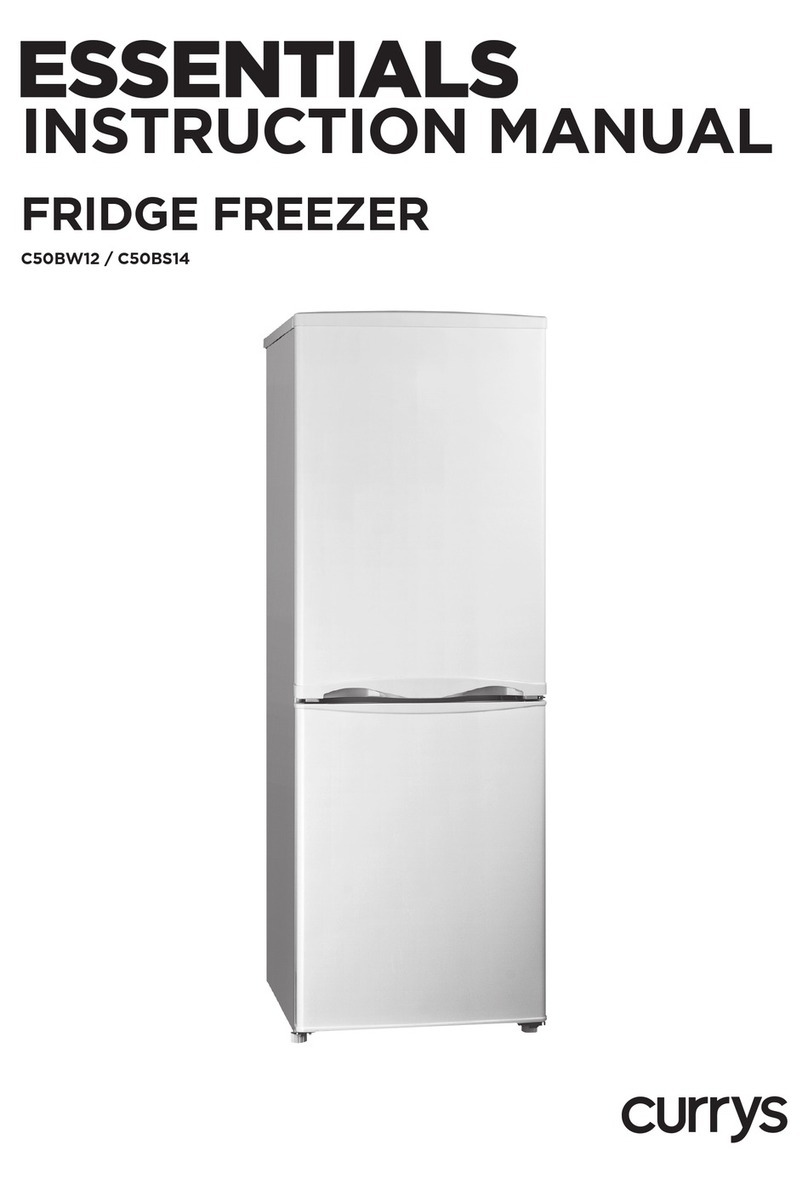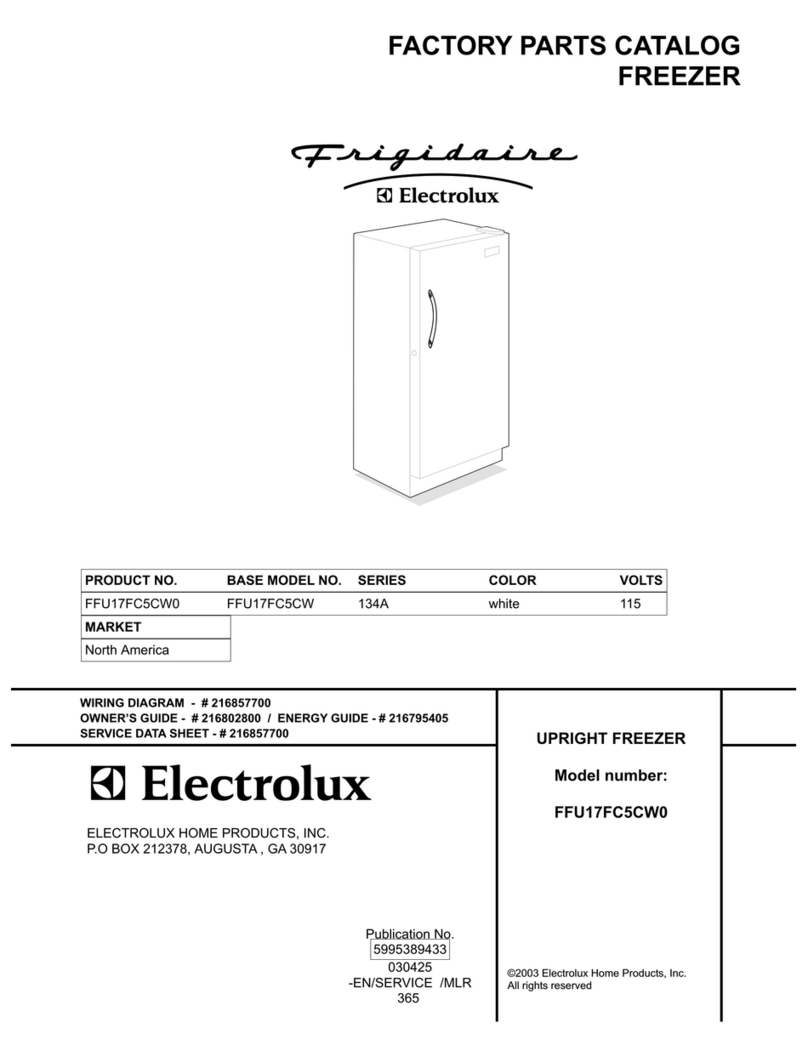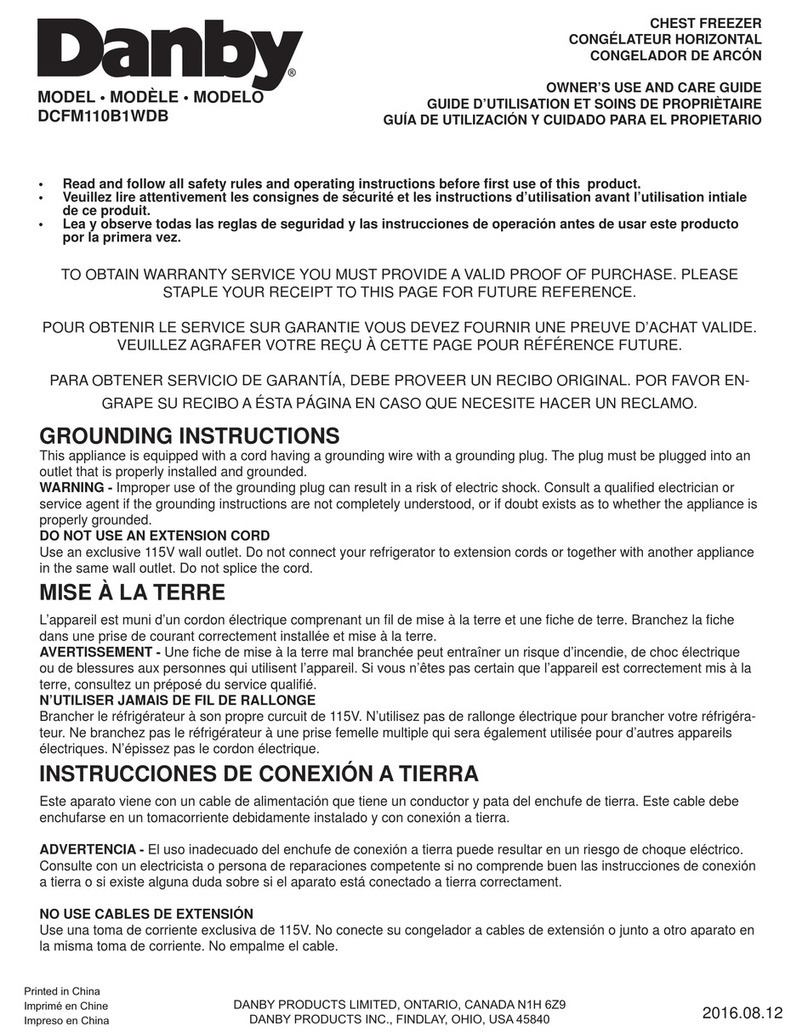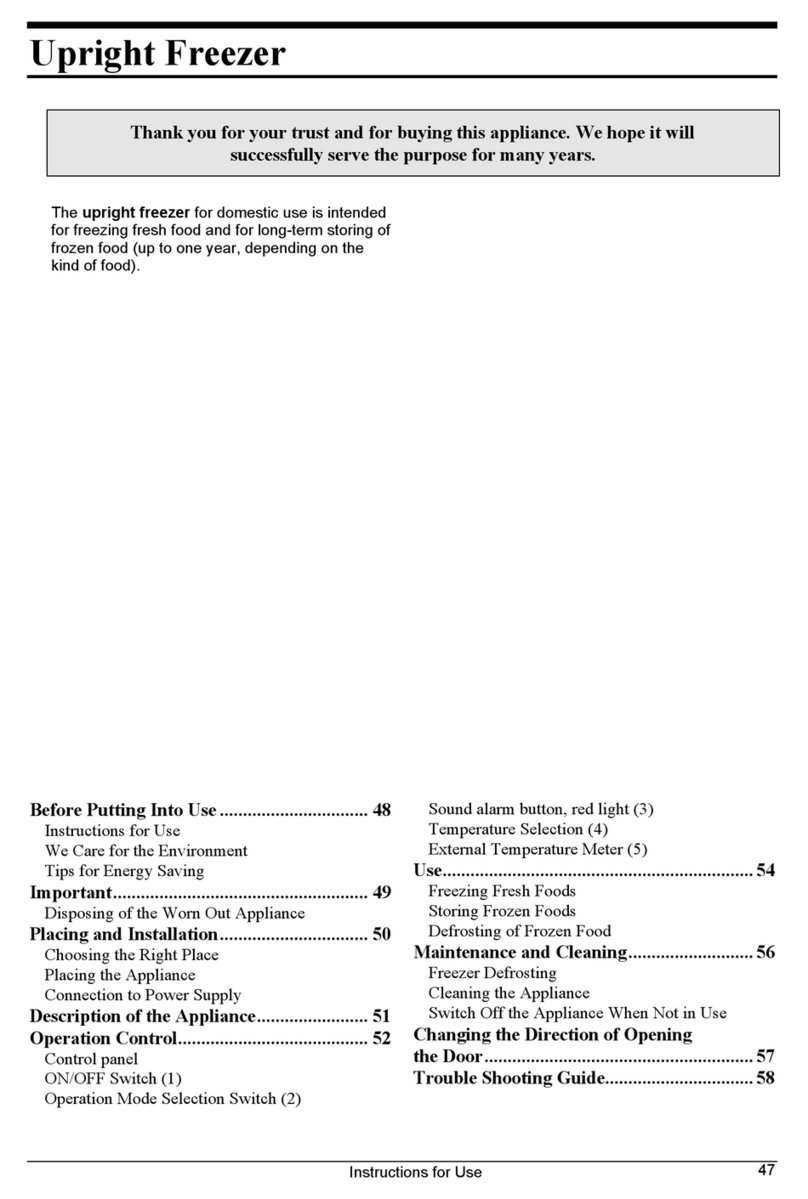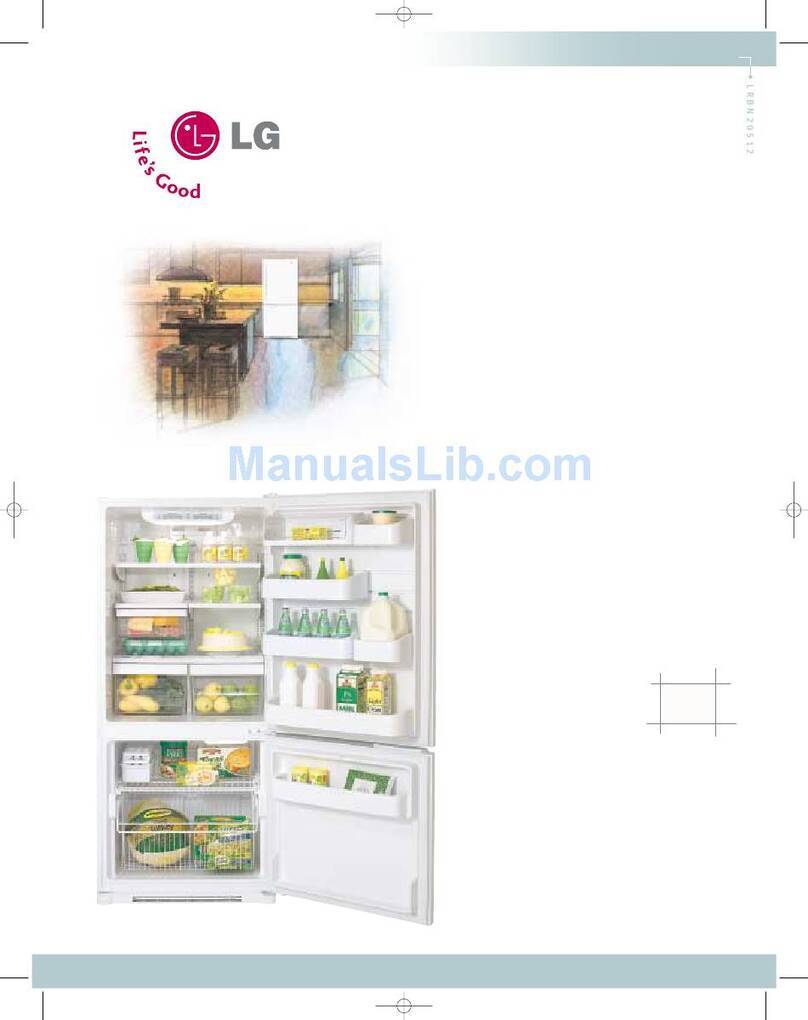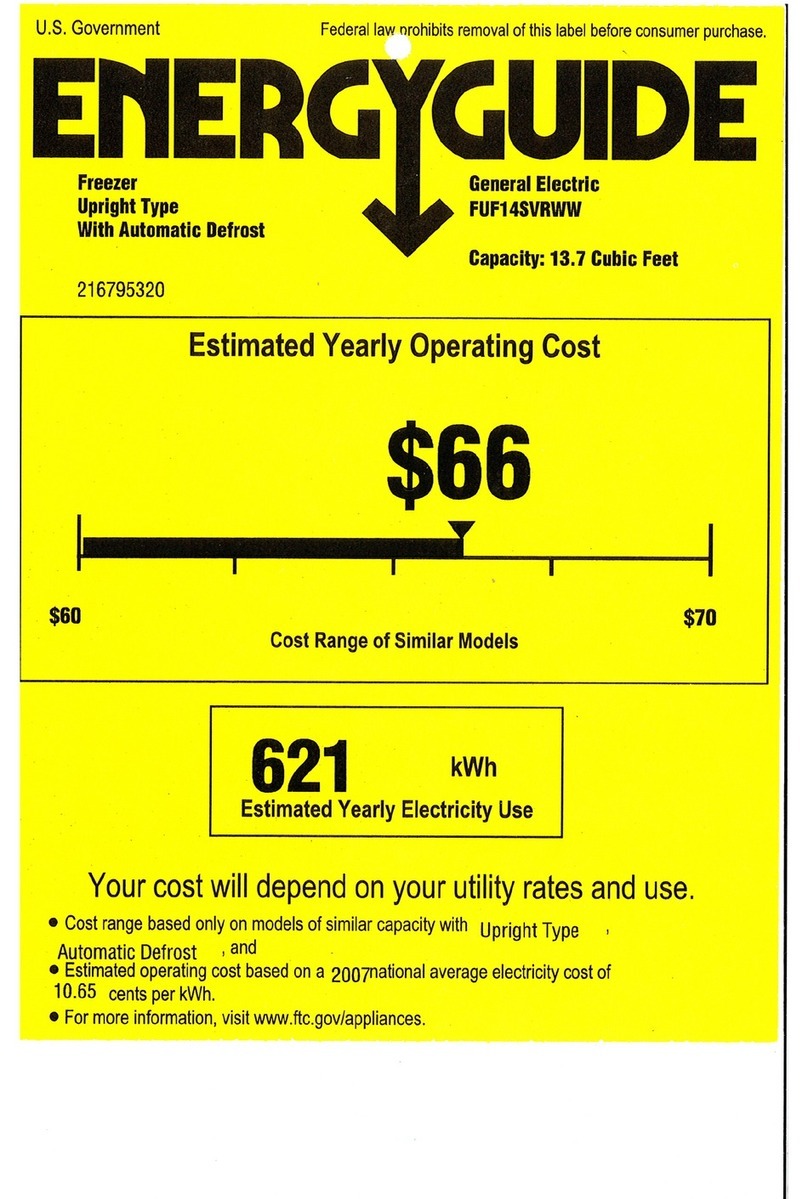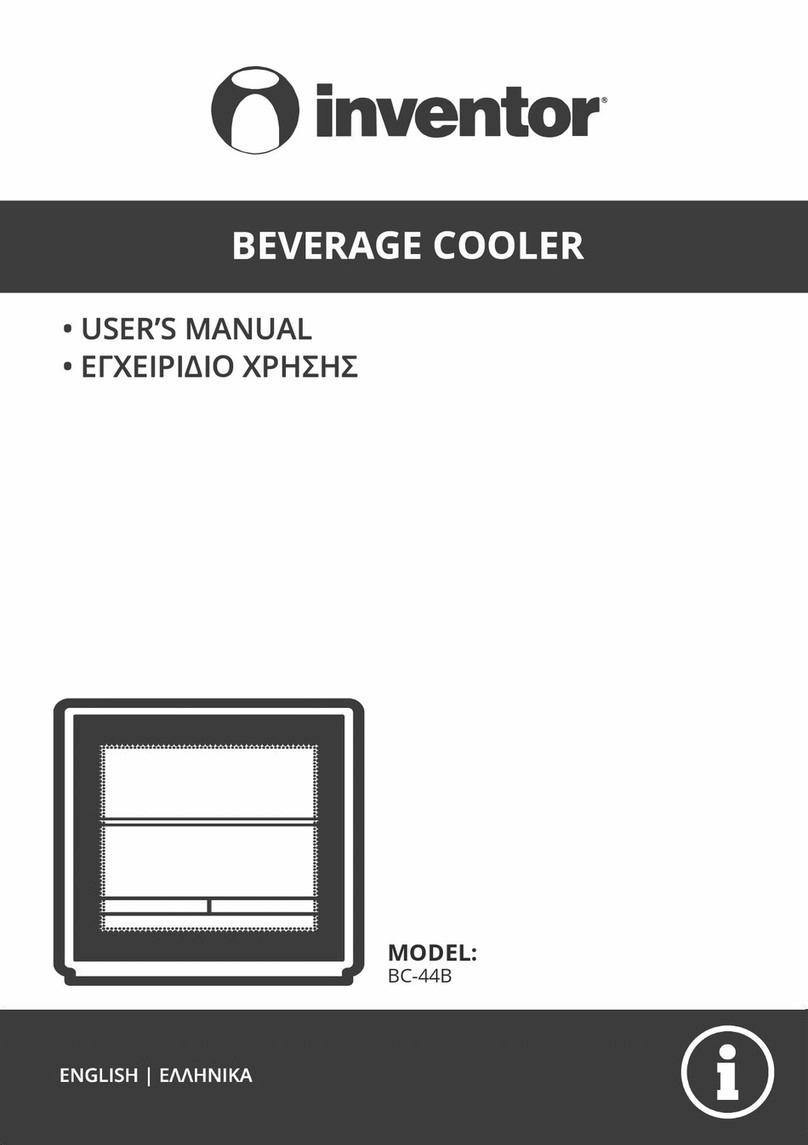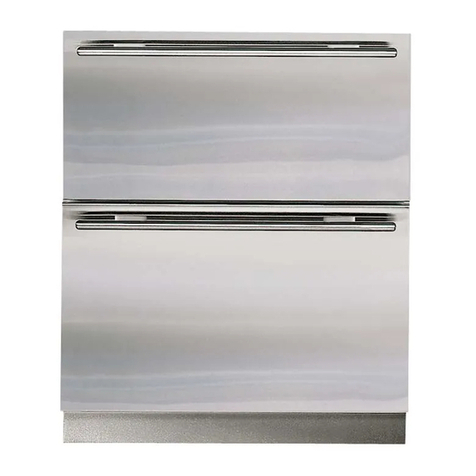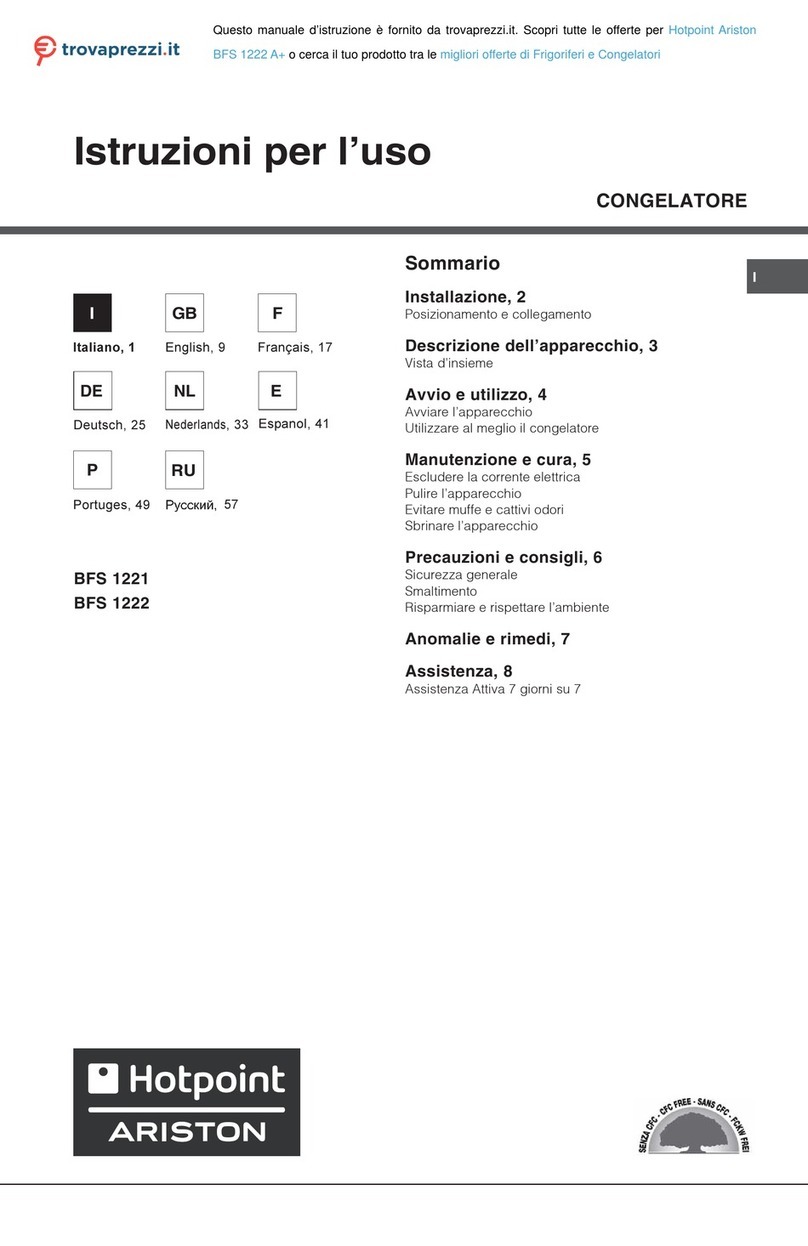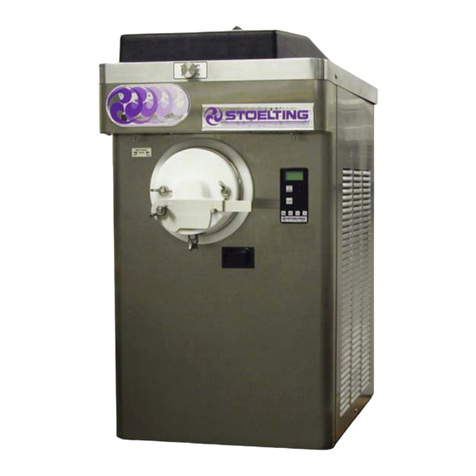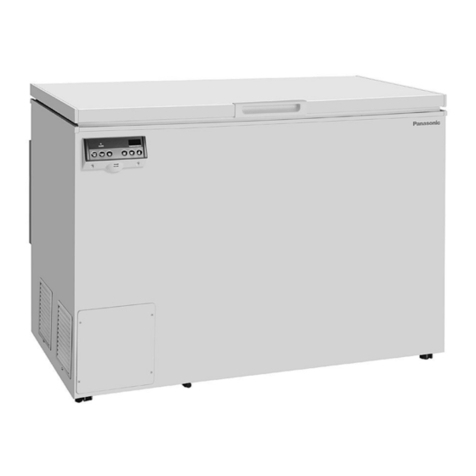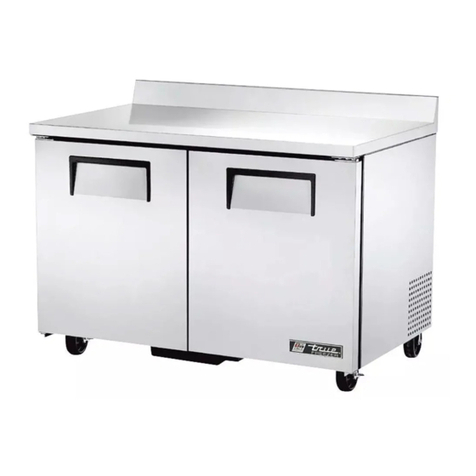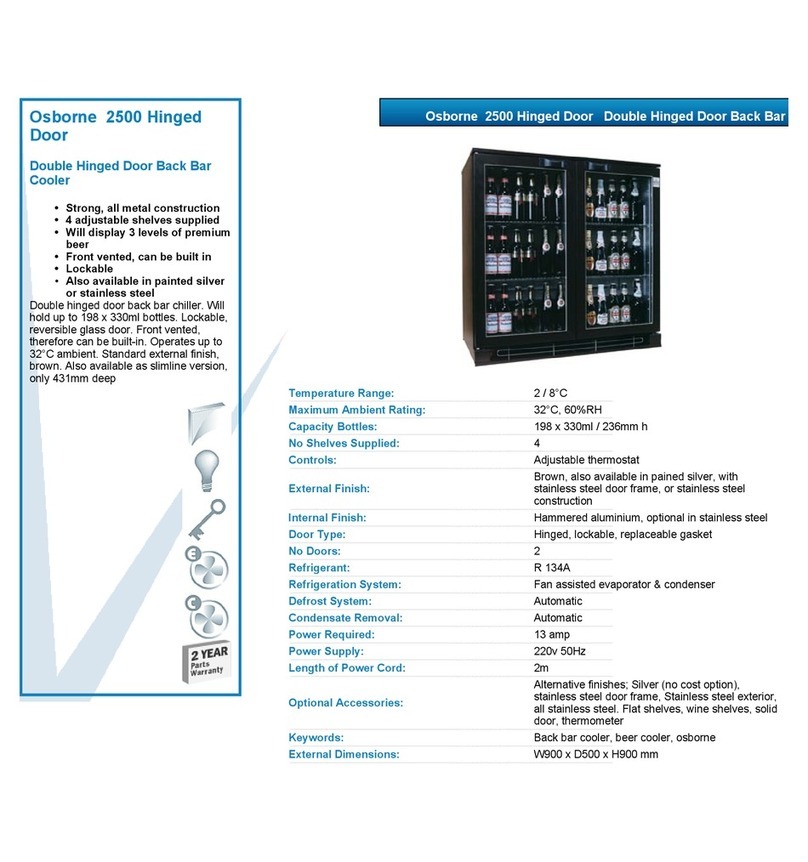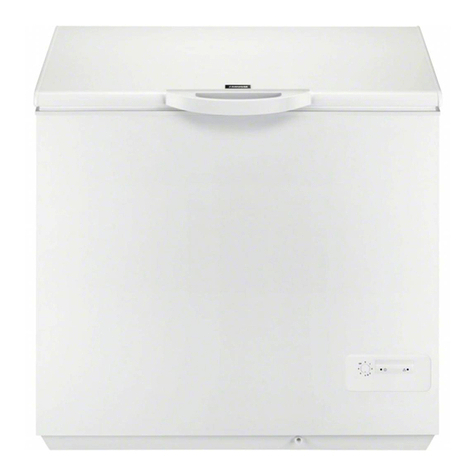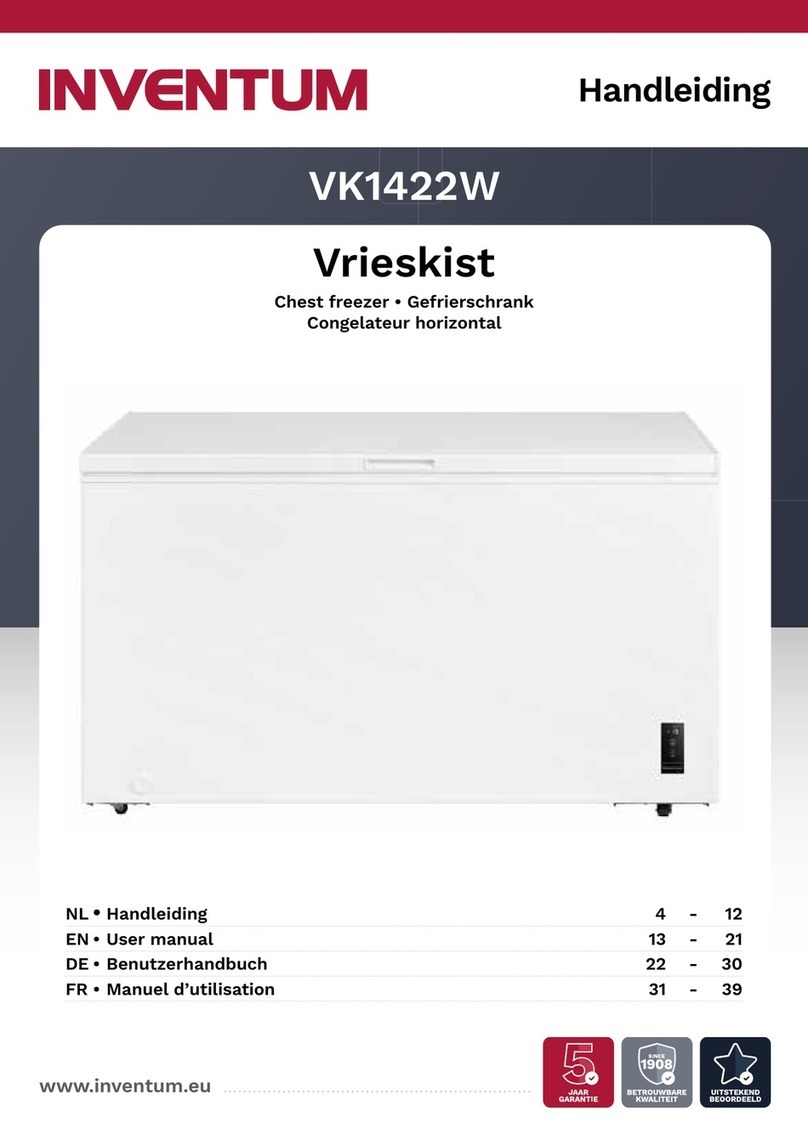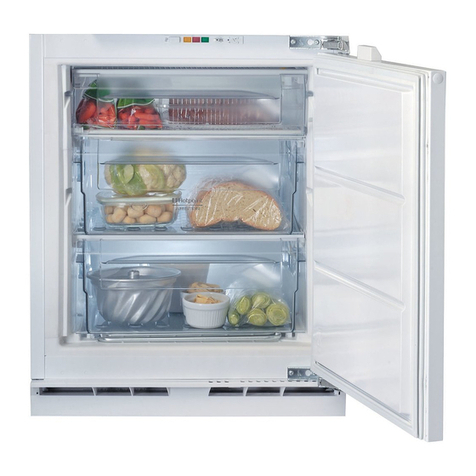Essentials CUF55B19 Service manual

1
SAFETY WARNINGS
REFRIGERATOR
For your continued safety and to reduce the risk of injury or electric shock,
please follow all the safety precautions listed below.
• Read all instructions carefully before using the unit and keep them for
future reference.
• Retain the manual. If you pass the unit onto a third party, make sure to
include this manual.
• This appliance is intended for indoor household use and similar
applications such as:
– farm houses and by clients in hotels, motels and other residential type
environment;
– bed and breakfast type environment;
– sta kitchen areas in shops, oces and other working environment;
– catering and similar non-retail applications.
• Ensure that the plug is easily accessible to enable disconnection from
the mains supply.
• If the mains cable is damaged, it must be replaced by the manufacturer,
its service agent or a qualied technician in order to avoid a hazard.
• Choose a location for your unit away from heat sources such as radiators
or res as refrigerant and vesicant are burnable.
• The unit must be manoeuvred by a minimum of 2 persons.
• This appliance can be used by children aged from 8 years and above
and persons with reduced physical, sensory or mental capabilities or
lack of experience and knowledge if they have been given supervision
or instruction concerning use of the appliance in a safe way and
understand the hazards involved. Children shall not play with the
appliance. Cleaning and user maintenance shall not be made by
children without supervision.
• Children aged from 3 to 8 years are allowed to load and unload
refrigerating appliances.
• Children should be supervised to ensure that they do not play with the
unit.
• If your unit is tted with a lock to prevent children being trapped inside,
keep the key out of reach and not in the vicinity of the unit.
• Do not store explosive substances such as aerosol cans with a
ammable propellant in this appliance.
IB safety_Refrigerator_UK_Final200420.indd 1IB safety_Refrigerator_UK_Final200420.indd 1 23/4/2020 7:11 PM23/4/2020 7:11 PM

2
• Do not store bottles or glass containers in the freezer compartment.
Contents can expand when frozen (zzy drinks) which may break the
bottle and damage your freezer compartment. (If applicable)
• To avoid contamination of food, pay attention to the following:
-opening the door for long periods can cause a significant increase of
the temperature in the compartments of the appliance;
-clean regularly surfaces that can come in contact with food and
accessible drainage systems;
-clean water tanks if they have not been used for 48 hours; flush the
water system connected to a water supply if water has not been
drawn for 5 days;
-store raw meat and fish in suitable containers in the refrigerator so
that it is not in contact with or drip onto other food;
-two-star frozen-food compartments are suitable for storing pre-
frozen food, storing or making ice-cream and making ice cubes;
-one-, two- and three-star compartments are not suitable for the
freezing of fresh food;
-if the refrigerating appliance is left empty for long periods, switch
off, defrost, clean, dry and leave the door open to prevent mould
developing within the appliance.
• Do not place heavy or wet items on top of the appliance.
WARNING
IT IS HAZARDOUS FOR ANYONE OTHER THAN AUTHORISED SERVICE
PERSONNEL TO CARRY OUT SERVICING OF REPAIRS WHICH INVOLVE
THE REMOVAL OF COVERS.
TO AVOID THE RISK OF AN ELECTRICAL SHOCK DO NOT ATTEMPT
REPAIRS YOURSELF.
IB safety_Refrigerator_UK_Final200420.indd 2IB safety_Refrigerator_UK_Final200420.indd 2 23/4/2020 7:11 PM23/4/2020 7:11 PM

3
The table below contains general guidelines on the storage of food in the
refrigerator (wherever applicable).
Refrigerator location Type of food
Fridge door • Foods with natural preservatives, such as
jams, juices, drinks, condiments.
• Do not store perishable foods.
Crisper bin (salad bin) • Fruits, herbs and vegetables should be
placed separately in the crisper bin.
• Do not store bananas, onions, potatoes,
garlic in the refrigerator.
• Fridge shelf – bottom
• Chiller bin
Raw meat, poultry, sh (for short-term
storage)
Fridge shelf – middle Dairy products, eggs
Fridge shelf – top Foods that do not need cooking, such as
ready-to-eat foods, deli meats, leftovers.
Freezer drawer/shelf • Foods for long-term storage.
• Bottom drawer/shelf for raw meat,
poultry, sh.
• Middle drawer/shelf for frozen vegetables,
chips.
• Top drawer/shelf for ice cream, frozen
fruit, frozen baked goods.
IB safety_Refrigerator_UK_Final200420.indd 3IB safety_Refrigerator_UK_Final200420.indd 3 23/4/2020 7:11 PM23/4/2020 7:11 PM

4
• Properly storing foods in the fridge or freezer with the correct
temperature settings can help prevent foods from spoiling easily and
thus help prevent food waste. For example, for peeled or cut veggies,
storing them in the fridge (fresh food area) for 2 to 3 days instead of
leaving then out at room temperature can retain their freshness and
keep them from going bad. Meats and seafoods can be stored in the
freezer (-18°C) for months without going bad.
The table below contains general guidelines on the storage temperature
in each compartment type (wherever applicable).
Compartment Storage temperature
(°C)
Unfrozen
compartments
Pantry 17
Fresh food 4
Wine storage 12
Cellar 12
Chill compartment Chiller bin 2
Frozen compartments 0-star & ice-making 0
1-star -6
2-star -12
3-star -18
freezer (4-star) -18
IB safety_Refrigerator_UK_Final200420.indd 4IB safety_Refrigerator_UK_Final200420.indd 4 23/4/2020 7:11 PM23/4/2020 7:11 PM

5
WARNING
• Keep ventilation openings in the unit enclosure or in the built-in
structure clear of obstructions.
• Do not use mechanical devices or other means to accelerate
the defrosting process, other than those recommended by the
manufacturer.
• Do not use electrical appliances inside the food storage
compartments of the unit, unless they are of the type
recommended by the manufacturer.
• Do not damage the refrigerant circuit (The refrigerant is a very
environmental-friendly gas but is also combustible. Take care when
transporting or moving the unit to ensure that the refrigeration
circuit is not damaged. In the event of damage avoid naked flames
or ignition sources and ventilate the room in which the unit is
placed for a few minutes.)
• When positioning the appliance, ensure the supply cord is not
trapped or damaged.
• Do not locate multiple portable socket-outlets or portable power
supplies at the rear of the appliance.
WARNING: Risk of re/ammable materials
IB safety_Refrigerator_UK_Final200420.indd 5IB safety_Refrigerator_UK_Final200420.indd 5 23/4/2020 7:11 PM23/4/2020 7:11 PM

The symbol on the product or its packaging indicates that this
product must not be disposed of with your other household
waste. Instead, it is your responsibility to dispose of your waste
equipment by handing it over to a designated collection point for
the recycling of waste electrical and electronic equipment. The
separate collection and recycling of your waste equipment at the
time of disposal will help conserve natural resources and ensure
that it is recycled in a manner that protects human health and
the environment.
For more information about where you can drop o your waste
for recycling, please contact your local authority, or where you
purchased your product.
Visit Partmaster.co.uk today for the easiest way to buy
electrical spares and accessories. With over 1 million
spares and accessories available we can deliver direct
to your door the very next day. Visit www.partmaster.co.uk or call 0344 800 3456
(UK customers only) Calls charged at National Rate.
IB safety_Refrigerator_UK_Final200420.indd 6IB safety_Refrigerator_UK_Final200420.indd 6 23/4/2020 7:11 PM23/4/2020 7:11 PM

IB safety_Refrigerator_UK_Final200420.indd 7IB safety_Refrigerator_UK_Final200420.indd 7 23/4/2020 7:11 PM23/4/2020 7:11 PM

IB safety-Refrigerator-UK-200420V1
DSG Retail Ltd. (co. no. 504877)
1 Portal Way, London, W3 6RS, UK
EU Representative
DSG Retail Ireland Ltd (259460)
3rd Floor Oce Suite,
Omni Park SC, Santry, Dublin 9, Republic of Ireland
IB safety_Refrigerator_UK_Final200420.indd 8IB safety_Refrigerator_UK_Final200420.indd 8 23/4/2020 7:11 PM23/4/2020 7:11 PM

Undercounter Freezer
Installation / Instruction Manual
CUF55B19 / CUF55W19 / CUF55S19
CUF55B_W_S19_IB_RC_200617_grace.indd 1CUF55B_W_S19_IB_RC_200617_grace.indd 1 17/6/2020 5:24 PM17/6/2020 5:24 PM

CUF55B_W_S19_IB_RC_200617_grace.indd 2CUF55B_W_S19_IB_RC_200617_grace.indd 2 17/6/2020 5:24 PM17/6/2020 5:24 PM

Contents
Unpacking............................................................................................................................................4
Installation ...........................................................................................................................................5
Location ...............................................................................................................................................................................5
Levelling the Unit .............................................................................................................................................................5
Free Space Requirements..............................................................................................................................................5
Reversing the Door Swing.............................................................................................................................................6
Cleaning Before Use ........................................................................................................................................................9
Before Using Your Unit....................................................................................................................................................9
Product Overview..............................................................................................................................10
Operation ...........................................................................................................................................11
Switching On Your Unit ............................................................................................................................................... 11
Adjusting the Temperature........................................................................................................................................ 11
Noises Inside the Unit!................................................................................................................................................. 11
Preparations for Freezing............................................................................................................................................ 12
Defrosting Frozen Food............................................................................................................................................... 12
Cleaning .............................................................................................................................................13
Defrosting ........................................................................................................................................................................ 13
Cleaning the Interior and the Exterior of the Unit............................................................................................. 13
Maintenance ......................................................................................................................................14
Care When Handling / Moving the Unit................................................................................................................ 14
Servicing........................................................................................................................................................................... 14
Switching O for Long Periods of Time................................................................................................................. 14
Condensation.................................................................................................................................................................. 14
Disposal..............................................................................................................................................14
Specications.....................................................................................................................................15
CUF55B_W_S19_IB_RC_200617_grace.indd 3CUF55B_W_S19_IB_RC_200617_grace.indd 3 17/6/2020 5:24 PM17/6/2020 5:24 PM

4
Unpacking
Remove all items from the packaging. Retain the packaging. If you dispose of it please do so
according to local regulations.
The following items are included:
The Main Unit
Freezer Drawer x 3 Ice Tray
Instruction Manual
Instruction
Manual
If items are missing, or damaged please contact Partmaster (UK only).
Tel: 0344 800 3456 for assistance.
Thank you for purchasing your new product.
We recommend that you spend some time reading this instruction
manual in order that you fully understand all the operational features
it oers. You will also nd some hints and tips to help you resolve any
issues.
Read all the safety instructions carefully before use and keep this
instruction manual for future reference.
Turning Thermostat
Piece
CUF55B_W_S19_IB_RC_200617_grace.indd 4CUF55B_W_S19_IB_RC_200617_grace.indd 4 17/6/2020 5:24 PM17/6/2020 5:24 PM

5
INSTALLATION
Location
When selecting a position for your unit you should make sure the oor is at and rm, and
the room is well ventilated with an average room temperature of between 16°C and 38°C.
Avoid locating your unit near a heat source, e.g. cooker, boiler or radiator. Also avoid direct
sunlight as it may increase the electrical consumption. Extreme cold ambient temperatures
may also cause the unit not to perform properly. This unit is suitable for use in a garage or
outbuilding. Do not drape the unit with any covering. This refrigerating appliance is not
intended to be used as a built-in appliance.
Levelling the Unit
To do this adjust the two levelling feet at the front of the unit.
If the unit is not level, the doors and magnetic seal alignments
will not be covered properly.
Free Space Requirements
When installing the unit, ensure that 25 mm
of free space is left at both sides, 50 mm at
the rear of the unit and 25 mm at the top of
the unit. The door can be opened to the right
or the left, depending on which best suits
the location.
Please ensure there is more than twice the
width and depth distance space of the unit
to fully open the door to a maximum angle.
Y mm
X mm
CUF55B_W_S19_IB_RC_200617_grace.indd 5CUF55B_W_S19_IB_RC_200617_grace.indd 5 17/6/2020 5:24 PM17/6/2020 5:24 PM

6
INSTALLATION
If the appliance is placed under a continuous worktop, a ventilation grille of at least 200
cm2(available from DIY shops or specialist retailers) should be installed (if applicable) to the
worktop above the rear of the appliance to increase ventilation.
Benets of increased ventilation:
• Lowered power consumption • Improved cooling performance
• Reduce running costs • Prolong product life span
min. 200 cm2
Reversing the Door Swing
Tools required: Philips style screwdriver / Flat bladed screwdriver / Hexagonal spanner
1. Remove the 2 screws on the back.
• Ensure the unit is unplugged and empty.
• To take the door o it is necessary to tilt the unit backwards. You should rest the
unit on something solid, e.g. a chair just below the top panel.
• All parts removed must be saved to do the reinstallation of the door.
• Do not lay the unit at as this may damage the coolant system.
• We recommend that 2 people handle the unit during assembly.
• If you want to have the door swing reversed, we recommend that you contact a
qualied technician. You should only try to reverse the door yourself if you believe
that you are qualied to do so.
CUF55B_W_S19_IB_RC_200617_grace.indd 6CUF55B_W_S19_IB_RC_200617_grace.indd 6 17/6/2020 5:24 PM17/6/2020 5:24 PM

7
INSTALLATION
2. Lift the top cover away from the fridge.
3. Remove the upper screws, then remove
the upper hinge that hold the door
in place. Lift the door and place it on
a padded surface to prevent it from
scratching.
4. Swap the bottom bushing and bottom
bushing cap of the door. The bottom
bushing key must be in the correct
position to allow it to be inserted
correctly.
5. Remove the bottom screws, bottom
hinge and levelling feet from the unit
bottom.
unscrew unscrew
• Do not lay the unit at as this may
damage the coolant system.
• During door reversal, when
swapping the position of the
bottom hinge or adjusting the
levelling feet, tilt the unit. Do not
lay the unit at.
CUF55B_W_S19_IB_RC_200617_grace.indd 7CUF55B_W_S19_IB_RC_200617_grace.indd 7 17/6/2020 5:24 PM17/6/2020 5:24 PM

8
INSTALLATION
screw
screw
6. Remove the levelling feet from another
side of the unit bottom and transfer it
to the corresponding position on the
opposite side of the unit bottom.
7. Reattach the bottom screws, bottom
hinge and levelling feet to the opposite
side of the unit bottom. Loosely secure.
8. Carefully set the door back into place.
Install the upper hinge and screws.
Ensure the door is aligned horizontally
and vertically so that the seals are closed
on all sides before nally tightening the
upper hinge.
Use a spanner to tighten it if necessary.
10. With the door closed, check that the
door is aligned horizontally and vertically
and that the seals are closed on all sides
before nally tightening the bottom
hinge. Re-adjust the levelling feet as
needed.
9. Put the top cover back and x it in place
with the screws.
CUF55B_W_S19_IB_RC_200617_grace.indd 8CUF55B_W_S19_IB_RC_200617_grace.indd 8 17/6/2020 5:24 PM17/6/2020 5:24 PM

9
INSTALLATION
Cleaning Before Use
Wipe the inside of the unit with a weak solution of bicarbonate soda. Then rinse with warm
water using a sponge or cloth. Wipe completely dry before replacing the shelves, drawers and
salad bin. Clean the exterior of the unit with a damp cloth.
If you require more information refer to the Cleaning section.
Before Using Your Unit
Before placing any food in your unit, turn it on and wait for 24 hours, to make sure it is
working properly and to allow it time to fall to the correct temperature. Your unit should not
be overlled.
• Before Plugging in YOU MUST
Check that you have a socket which is compatible with the plug supplied with
the unit.
• Before Turning On!
Do not turn on until two hours after moving the unit. The coolant uid needs
time to settle.
In some cases, the door seal may be crushed after prolonged storing pressure,
resulting to the door seal not able to close properly when reversed.
Follow the steps below to solve the issue:
• Peel o the door seal from the upper or lower corner
and warm it with a hairdryer; the warmth can allow
the door seal to return to its original form. Do not
blow directly on the unit as the warmth may damage
other parts of the unit.
• Rotate the door seal upside down so that the side
originally with the hinge stay with the hinge.
• Insert the door seal back into the door from the upper
or lower corner.
• If the issue still occurs, contact your local service centre for assistance.
180°
CUF55B_W_S19_IB_RC_200617_grace.indd 9CUF55B_W_S19_IB_RC_200617_grace.indd 9 17/6/2020 5:24 PM17/6/2020 5:24 PM

10
Product Overview
Ice Tray
Freezer
Drawers
Thermostat Control Dial
Levelling Feet
All accessories such as drawers, shelves and balconies should be kept like the diagram
here for the most ecient use of energy.
CUF55B_W_S19_IB_RC_200617_grace.indd 10CUF55B_W_S19_IB_RC_200617_grace.indd 10 17/6/2020 5:24 PM17/6/2020 5:24 PM

11
Operation
Switching On Your Unit
1. Connect the mains cable to the mains socket. The internal temperature of your unit is
controlled by a thermostat. There are four settings, of which position 4is the coldest.
2. Adjust the thermostat control dial to the desired position, bear in mind that the higher the
number, the lower the temperature. Position 2is the recommended setting when operating
at normal room temperature (between 16°C and 38°C).
3. The unit may not operate at the correct temperature if it is in a particularly hot or a
particularly cold room, or if you open the door often.
4. To ensure that the unit is cool enough to suciently chill your food, wait 24 hours before
lling it with food.
5. If you are concerned that your unit is not being kept
cold enough and wish to check the temperature,
you will need a special fridge/freezer thermometer.
These are available from most supermarkets and
hardware shops.
Place the thermometer in the centre of the unit,
where it can be read easily. Leave overnight, the
temperature in the unit should be between -18°C or
lower.
Adjusting the Temperature
The internal temperature of the unit is controlled by a thermostat. 4position is the coldest
setting. The recommended position is 2, but it should be adjusted according to the environment.
Setting 4makes your unit operate at its coldest temperatures (approximately -28°C )
continuously. It helps to quickly freeze and retain more of the goodness of your food. After
freezing your food turn the thermostat control dial back to 2(-18°C). Never freeze large
quantities of fresh food at one time.
Noises Inside the Unit!
You may notice that your unit makes some unusual noises. Most of these are perfectly normal,
but you should be aware of them!
These noises are caused by the circulation of the refrigerant liquid in the cooling system. It has
become more pronounced since the introduction of CFC free gases. This is not a fault and will
not aect the performance of your unit. This is the compressor motor working, as it pumps the
refrigerant around the system.
CUF55B_W_S19_IB_RC_200617_grace.indd 11CUF55B_W_S19_IB_RC_200617_grace.indd 11 17/6/2020 5:24 PM17/6/2020 5:24 PM

12
Preparations for Freezing
• Use quality food and handle it as little as possible. Freeze food in small quantities as it freezes
faster, takes less time to defrost and enables you to control the quantity you need better.
• Leave cooked food to cool completely. Chill food before freezing if possible.
• Consider how you will want to cook the food before freezing it.
• Don’t freeze food in metal containers if you may want to microwave it straight from the
freezer.
• Use special freezer bags, freezer lm, polythene bags, plastic containers, and aluminium foil
(heavy duty grade only). If in doubt, double wrap your food. Don’t use aluminium foil for
acidic foods, e.g. citrus fruits. Don’t use thin cling lm, glass, or used food containers without
cleaning.
• Exclude as much air from the container as possible. You could buy a special vacuum pump
which sucks excessive air out of the packaging.
• Leave a small amount of air space when freezing liquids to allow expansion.
• You can use the space in the freezer most eciently if you freeze
liquids (or solids with liquids, e.g. stew) in square blocks. This is known
as “Preforming”. Pour the liquid into a polythene bag which is inside a
square sided container. Freeze it, and then remove it from the container
and seal the bag.
• Label your frozen foods as they will look the same when in frozen state.
Use special freezer tapes, labels and pens with dierent colours. This
allows you to easily organise and to eectively use the freezer. Write the
contents and date; otherwise the frozen food might exceed the storage
time and this could cause food poisoning. Please refer to your food
packaging for the recommended storage time.
• You may also add the weight and cooking notes, e.g. “defrost rst”, “cook from frozen” and
keep a separate log of what is in each drawer. This will save opening the door and searching
around unnecessarily.
Defrosting Frozen Food
• Take the frozen food out from the unit and uncover the frozen food. Let it defrost at room
temperature. Don’t forget that defrosting in a warm area encourages the growth of bacteria
and low temperature cooking may not destroy dangerous bacteria.
• Drain o and throw away any liquid lost during defrosting.
• Always make sure there are no ice-crystals in the food before cooking, particularly with meat.
These crystals indicate that the food has not fully defrosted.
• Cook food as soon as possible after defrosting.
• Many microwaves and ovens have a defrost setting. To avoid bacterial build up, only use
these if you intend to cook the food immediately afterwards.
Never re-freeze anything that has been defrosted unless you cook it again, to kill o
harmful bacteria. Never re-freeze defrosted shellsh. Re-seal packs properly after
removing items. This prevents drying or freezer-burn and a build up of frost on any
remaining food.
CUF55B_W_S19_IB_RC_200617_grace.indd 12CUF55B_W_S19_IB_RC_200617_grace.indd 12 17/6/2020 5:24 PM17/6/2020 5:24 PM
This manual suits for next models
2
Table of contents
Other Essentials Freezer manuals
